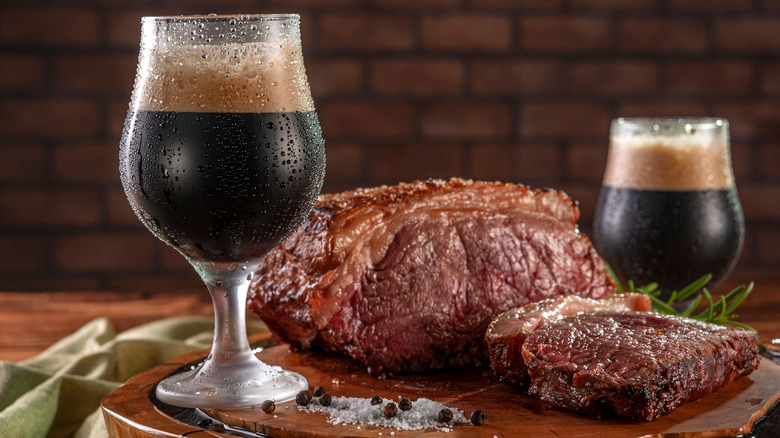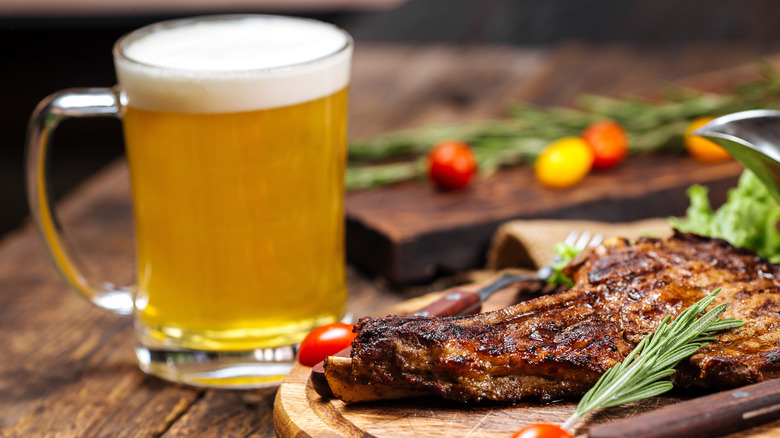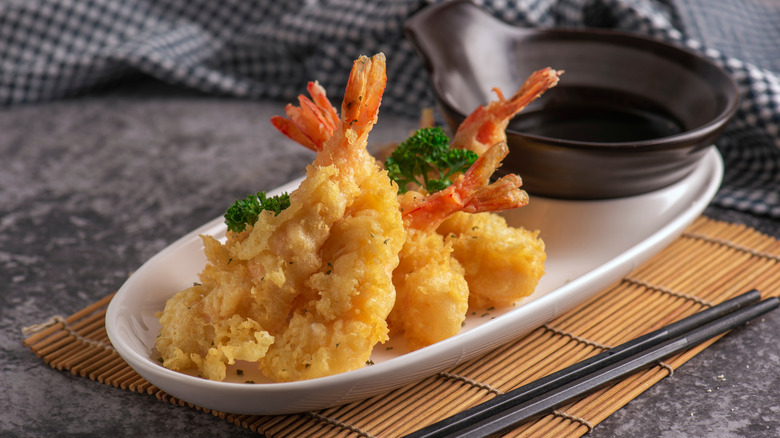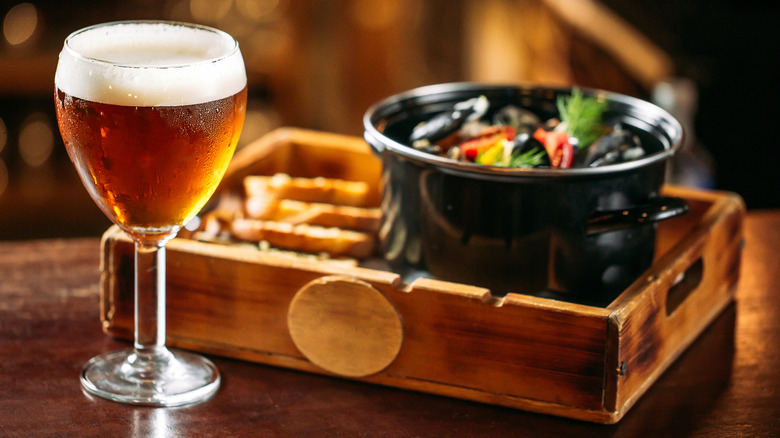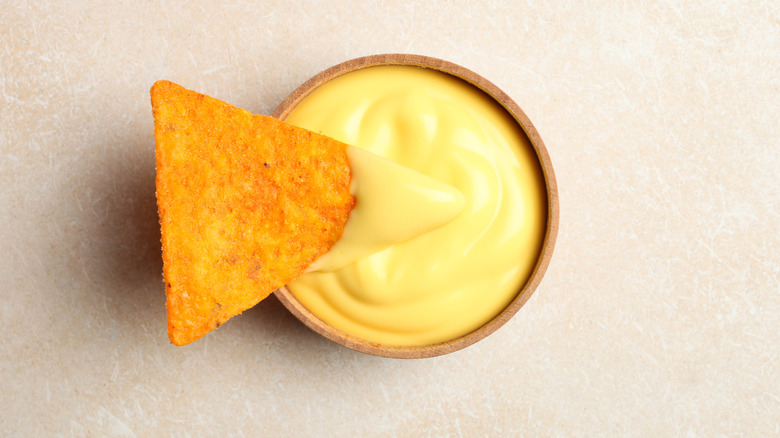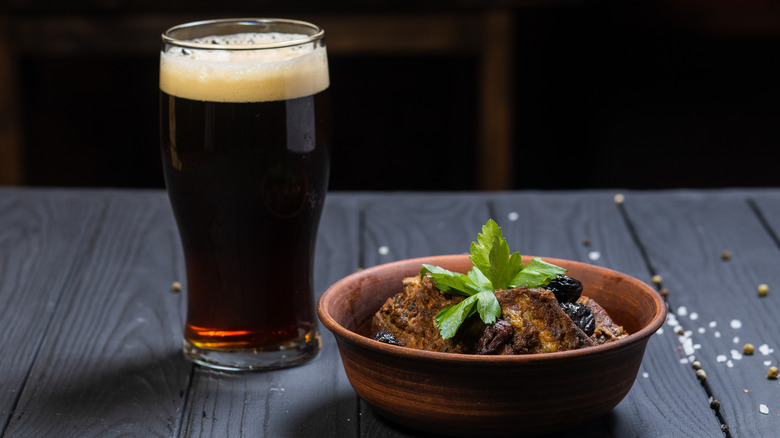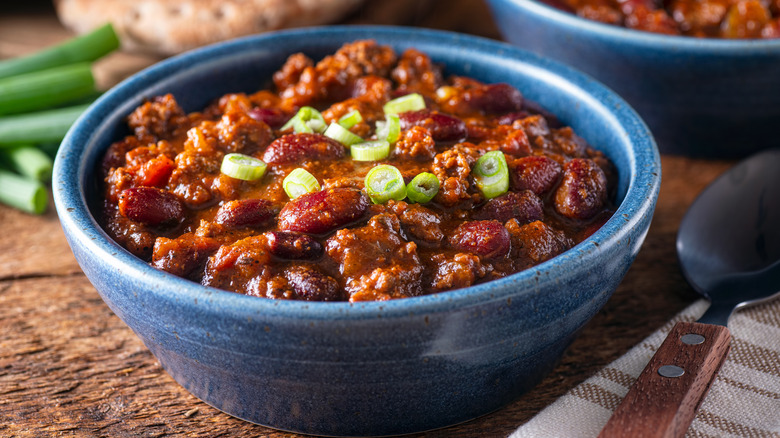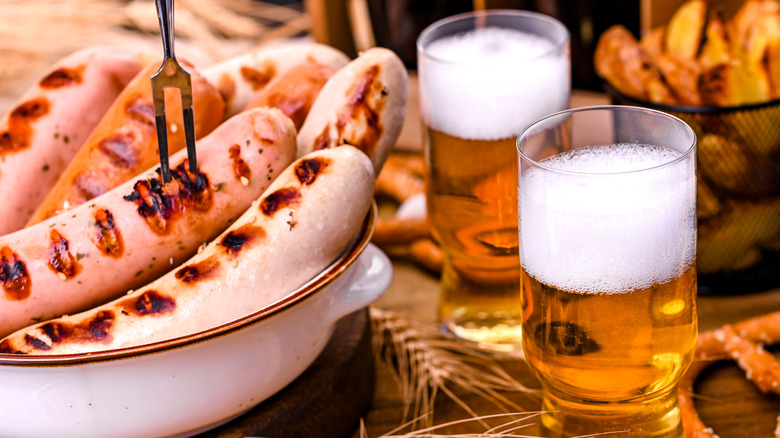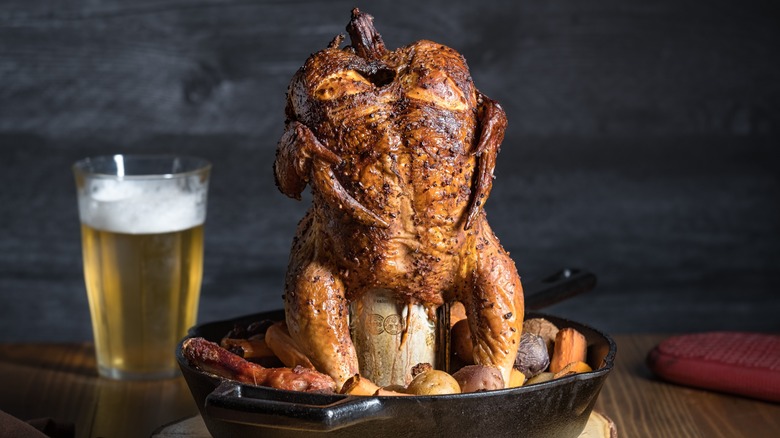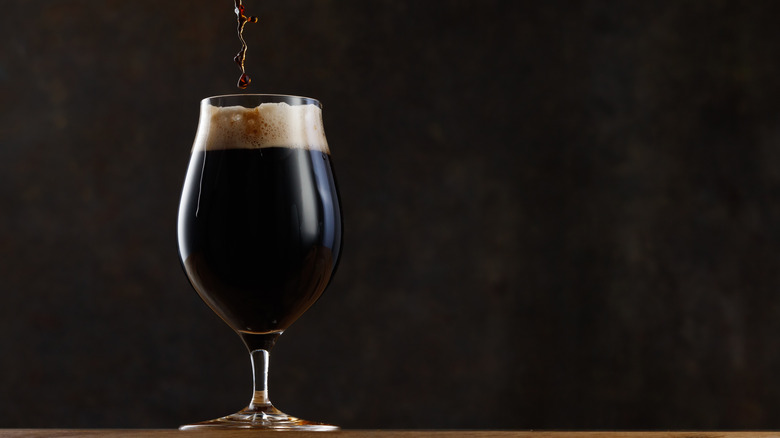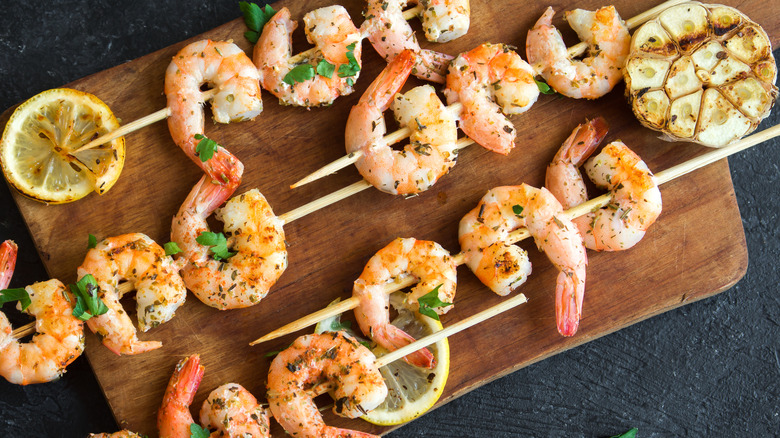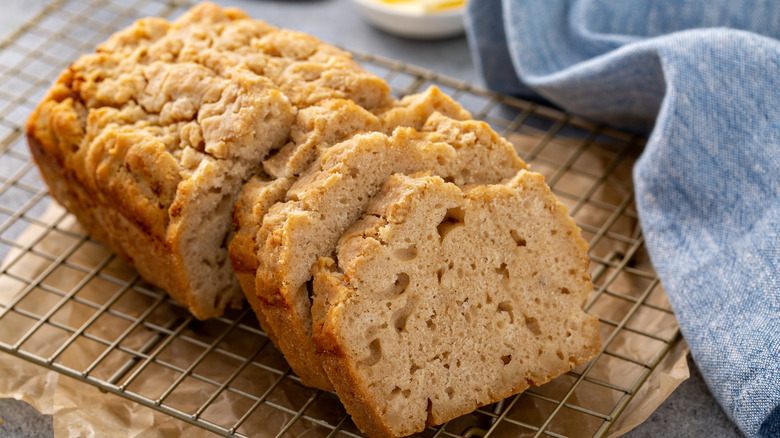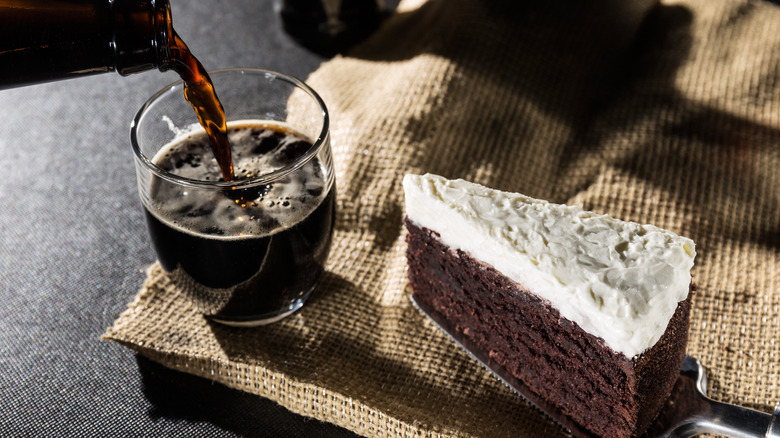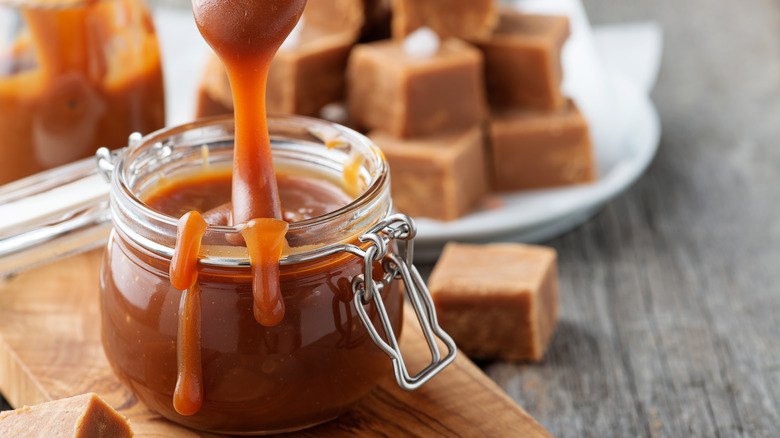The Beers You Should Be Cooking With And Why It Matters
Despite its ancient origin, beer still tops the list as the most popular alcoholic drink in the world. In the beer category, lagers and ales are the two dominant styles, but it is difficult to pinpoint the exact number of substyles that are brewed around the world. Following the craft revolution, there seems to be no end to creative combinations and new ways to tweak a traditional style. And though beer is the apparent winner in the drinking department, we often, undeservedly, shy away from using it in the kitchen, though it can significantly improve your cooking skills.
The effervescence in the beer will impart a light, airy texture to your cakes and batters, and all those malty, earthy, and sweet flavors we often associate with beer will become more prominent with cooking. However, as the styles are not equal, you cannot expect them to perform the same way or work well with every ingredient. This guide can be an excellent reference for traditional and less conventional pairings you can easily follow and test at home.
Use wheat beer for marinades
Wheat beer is a category that includes all styles where wheat is predominant or used in larger proportions. The percentages may vary, and the ratio will influence the final profile of the beer. Wheat beers stem from German brewing tradition, but the style has also developed in Belgium. In Germany, you will find them labeled as Hefeweizen, which is the most traditional representative, or Weissbier, while the Belgium counterpart uses the term witbier. You can expect these beers to be fresh, bright, citrusy, and very carbonated. Most are hazy and tend to have a smooth, creamy mouthfeel. Clove and banana-like aroma is sometimes present in traditional styles, and you can find some zesty and spicy notes in Belgium witbier as they are sometimes brewed with coriander and orange zest.
Wheat beers make excellent food pairing partners, and when it comes to cooking, they will also perform well in meat marinades, as the enzymes will help to break down fibers and proteins. The goal is to leave the meat inside the marinade to allow the enzymes to work magic, leaving you with a nice, tender piece of meat. Beer will also impart some flavor, and wheat beer will do an excellent job here as it will lend its character, but the toned-down profile will not take over or dominate other flavors. You can use wheat beer marinades with most types of meat, but it could also work with fattier fish.
Lagers are best for light tempura batter
Tempura is best described as a Japanese frying technique mainly used for seafood and vegetables. The most distinctive characteristic of this frying style is the somewhat runny batter used to coat the ingredients, resulting in a very light fried crust. Though it is a style now exclusively associated with Japan, Portuguese colonists most likely brought the technique to Japan during the Age of Exploration.
Typical tempura will incorporate eggs, water, and flour, but if you want a lighter texture and more flavor, try switching water with beer. In this case, your safest choice is to use a standard, light lager. Although it is a broad category filled with different substyles, a classic lager will be distinguished for its light body, refreshing flavor, and plenty of carbonation. These characteristics make it the ideal choice for tempura. The carbonation will make the batter lightweight, and you will get subtle lager sweetness in the flavor. Lagers are traditionally not overly bitter and hoppy, so you will not get any of the tart, unpleasant nuances that may appear during frying.
For the best results, stay clear of dark lagers and go for classic golden styles. Czech lagers such as pilsner or even typical American lager will do a decent job in tempura.
Steam mussels with Belgian blonde ales
Mussels are often called Belgium's national dish. The seafood specialty is available throughout the country, and you will typically see it labeled as moules-frites — an order that will include a big steaming pot of mussels and a basket of house-made fries on the side. Traditionally, Belgian mussels will be shortly steamed in a flavorful butter-based sauce that incorporates onions, garlic, and usually wine, but interpretations are virtually endless. Adding cream or crème fraîche is especially popular to make the sauce smoother and more luscious, and white wine is sometimes swapped with beer, which creates a variety known as moules à la bière. Regarding the beer selection in the recipe, the most reliable choice is a classic Belgian blonde ale.
Although Belgium has an ancient beer tradition that largely flourished in monasteries, blonde ale is not one of the old styles. In definition, very similar to golden ale, the blonde version is a perfect option for steamed mussels, as it has enough character and alcohol content to match the minerality of the mussels, but it is still approachable enough to allow other elements to come through. This is a beer style with some malty sweetness that is sometimes accompanied by hints of spicy and fruity nuances, which would ideally work with salt-packed seafood. The only thing missing in the equation is French fries, so make sure to have them on the side for the ultimate Belgian experience.
Choose a malty lager for beer cheese
Cheese dips may be ubiquitous worldwide, but beer cheese — a combination of gooey, melted cheese and beer — is a specialty whose origin is mainly associated with Kentucky. This is a cheesy dip you can serve on any occasion. It would go well with fries, roasted potatoes, pretzels, crackers, or more wholesome options such as celery sticks or carrots. Essentially, any snack or a small bite would pair nicely.
There is no set recipe for beer cheese. The essential ingredients are beer and cheese, but the flavor is easily tweaked with spices and condiments so you can adjust it to your taste. Beer cheese can be prepared with roux or simply by whipping up everything in a food processor. You should end up with a thick and creamy texture that is perfect for dipping.
Beer cheese is usually made with more pungent cheese varieties — in most cases, this will be regular cheddar cheese — and the best beer option for this occasion is a medium-bodied lager style — such as German Märzen or Vienna lager — that are brimming with toasty malt flavors. These lagers are slightly heavier than pilsners but do not go overboard with heaviness, so they should find a nice balance with the similar earthy and subtly sweet cheddar profile.
Use porter for robust stews and braised meat
Meat and beer are familiar partners. Though we usually like to pair them during a meal, this partnership can easily transfer to the kitchen. Ideally, you would want to put them side by side in rich, flavor-packed stews and robust braised meat dishes. Choosing a beer in this combination is pretty straightforward. Light lagers and citrusy ales would not be a worthy counterpart, but a splash of brawny porter will make a lot of difference.
Porter is a classic British malty ale with a grainy profile, complemented by subtle roastiness and slight hints of toffee and chocolate. Adding porter to stews and braises will add complexity, body, and character. The long cooking time will concentrate all the flavors, and the malt backbone will become more prominent. The malty characteristics will be especially welcome in the meat stews with onions and root veggies that typically pack a lot of sweetness. Beef would be the ideal type of meat for porter-flavored stews and braises.
Use stout when making chili
Chili is a hearty and flavorful dish, and if you want to elevate it with the addition of beer, you need something with an equally robust and complex flavor profile. Stout perfectly fits the description. Stout is one of the classic ale styles originating from the British Isles. Dry stout is the most traditional representative, but almost all examples are easily distinguished by the roasted barley that delivers most of its character. In accordance with the pitch-black color, typical dry stout will have roasted and grainy flavors, accompanied by bitterness from the hops, and a similar aromatic profile that may have hints of cocoa or coffee. Though there is only subtle sweetness on the palate, the texture will appear smooth and creamy.
Stout is a reliable addition to chili, as it lends some creaminess and blends with similar earthy flavors of the meat and spices. If chili is made with cocoa or chocolate, you can expect stout to do an outstanding job. Guinness, as the most famous stout, is the most obvious choice in this pairing, but do not be afraid to experiment with other styles. Stouts with some sweetness, such as oatmeal or sweet stout, could be a fantastic complement to the spiciness in the chili.
Cook your sausages with pilsner
Pilsner seems the most obvious choice when you're choosing the ideal beer for cooking sausages. The two usually pair naturally during a meal, so you can expect the same harmonious pairing in the kitchen. Pilsner is one of those unpretentious and beloved beer styles that is not famous or lauded for its complexity, but this beer is reliable and always delivers what is promised. Typical examples are golden, light, clean, and crisp beers with pleasant spicy and floral aromas that ideally work as thirst quenchers. You will get plenty of bitterness, but it will balance with a malty sweetness typical for the style. In the category, German and Czech pilsners are usually the benchmark styles.
For the beer-braised sausage recipe, go for pilsner and pork sausages, as the two can compare in character and flavor intensity. Pork sausages are often packed with spices and usually have a prevailing earthy profile that can pair nicely with all those bright, malty, and bitter pilsner flavors. During cooking, the alcohol will evaporate, but the flavors will become more concentrated, and you will be able to taste all that malty beer sweetness in the sausages. German and Czech pilsner can work here, but you can also go for the American version if you can get your hands on a craft beer.
Use classic pale ale with chicken
Chicken is the easiest protein to cook with. Whether you are a white or dark meat fan, both options have a relatively neutral flavor that can be paired with numerous spices, seasonings, and marinades. Similarly, it can be an excellent partner with various beer styles, but the best option is to go with something light, smooth, and approachable, but with enough body and flavor. Pale ale comes out as one of the most reliable options. This classic style is known for the pleasant balance of malt and hops, often backed by some fruitiness. American pale ale can sometimes be too hoppy and potent, so choose the toned-down original British version for cooking.
A classic beer and chicken pairing that would be ideal with pale ale is the beer can chicken recipe, in which a whole bird is perked up on a can of beer. In the oven, the beer will slowly bubble and release some steam, keeping inside moist while imparting flavor. Ideally, in this combination, you would perhaps want to marinate or just baste the chicken in the same beer before putting it in the oven. This would add a fantastic complementary flavor and crisp up the skin.
Dark lager is perfect for beans
Beans can be cooked in numerous ways, but we mostly like to pair them with meat or drown them in tomato sauces and stews where they best show their brawny, earthy character. If you are using beans in a similar fashion, do not be afraid to replace some of the liquid with beer. Beans are substantial enough to handle strong and potent flavors and can only benefit from some additional elements in the mix. With beans, you want a beer that is not too perky and bitter, but you also do not want to smother them with porters and stouts that can be too malty and roasty. Dark lager falls somewhere in the middle and would be a perfect match with beans.
Lager is the most popular beer style, but dark versions are not really common in the U.S. Their brewing tradition stems from central Europe, and they are primarily associated with Germany, where you will find several subcategories such as dunkel, bock, and schwarzbier. The exact characteristics of these beers can vary, but you can expect to get malty beers with some toastiness. They will have a clean and refreshing palate, which makes them quite approachable and a great option to match with the intensity of beans.
Use IPAs with shrimp
IPA is the absolute champion of the craft beer movement, but this aromatic beast can sometimes be a tricky partner in the kitchen. Classic IPA is a bright and bold ale made with copious amounts of hops that deliver considerable bitterness and potent aromas reminiscent of citrus, herbs, and flowers. This complex character is why we love IPA, but in the kitchen, it is often considered a too extravagant and sometimes a tad overwhelming. However, IPA can work well with seafood. In an ideal combination, you will use it with sweet and juicy shrimps.
As IPA does not do well with heat — long simmers will only amplify its high bitterness — shrimp is the perfect option, as it usually takes a few minutes to cook. Tender and subtly sweet shrimp meat generally pairs well with bitter flavors, citruses, and herbs, so you can expect them to work well with similar profiles found in a classic IPA. Use IPA for marinades, to baste grilled shrimp, or to deglaze all the pan juices. Remember that not all examples are created equal, and do not immediately choose the insanely hopped version for cooking. Instead, play it safe and go for something that is moderately accentuated.
Best beer for beer bread is German Hefeweizen
For the inexperienced, hefeweizen might sound intimidating, but essentially, the name is a reference to the most popular German wheat beer. Though this style is fantastic for drinking, it can also make an excellent cooking ingredient. Classic hefeweizen is usually highly carbonated and unfiltered hazy beer. The wheat provides the beer with a faintly sweet flavor, while the yeast often delivers nuances that are reminiscent of bananas and cloves — which is one of its most distinguishing characteristics. Despite the richness of the nose and the palate, this is a clean and bright style that remains approachable and refreshing.
You will not find much hop bitterness inside the classic examples, which makes hefeweizen a perfect addition to baked goods. The best way to highlight its strengths is in the simple beer bread. As these beers are not overly bitter, baking will not disrupt the flavor balance. The beer will deliver some of its sweetness and those spicy and fruity aromas, while the carbonization will keep the texture light and airy, resulting in an evenly distributed crumb. Besides savory versions, you can easily use hefeweizen for sweet loaves. Banana bread would perhaps be the most suitable pairing with this wheat style.
Chocolate stout is ideal for dark chocolate cakes
Stout and chocolate cakes have long been known as a match made in beer heaven. The combination works well because the two have similar dark and brawny profiles that complement each other in desserts. Generally, stout is a beer style with roasted qualities, often accompanied by hints of coffee, nuts, and chocolate. This dark brew will provide plenty of flavor in desserts, and it is a safe choice for classic chocolate brownies. However, if you want to elevate this pairing to the next level, swap the regular dry stout with a more assertive chocolate stout.
As the name suggests, chocolate stout starts as the classic style but also includes the addition of chocolate or any cocoa derivate in the brew. Producers frequently opt for more malt that will help promote chocolaty nuances inside the beer. Like in a regular stout, the emphasis leans towards the malt and roastiness rather than the hops. Adding chocolate stout to sweet-ladened brownies and chocolate cakes will provide a beautiful malty backbone, while similar flavor profiles will achieve perfect harmony. As chocolate stout is not readily found in most supermarkets, you can swap it with oatmeal or milk stouts, two styles with more sweetness and a slightly fuller profile that pair ideally with chocolate.
Best choice for caramel is amber ale
Though untraditional, beer can be nicely incorporated into caramel. Here you want to stick with medium-flavored styles that are not overly hoppy. As caramel usually spends some time on the stove to bubble and thicken, you will get more concentrated flavors from the beer. You'll want to avoid going with a lot of citrus and bitterness, as the flavors do not agree with caramel. The perfect option in this pairing is a classic amber ale, a beer already packed with caramel notes.
Amber ale is a style with vague origins whose qualities are not strictly standardized, but most examples use roasted crystal malt and sometimes incorporate caramel. The combination results in a beer with a medium body and amber color. This style is similar to pale ale, but has a rounded and more robust profile. Hops are present but not prominent, so it is not supposed to cause any imbalance. To be on the safe side, go for beers that lean more toward the malty caramel side and avoid the ambitiously hopped labels.
